Investment markets and key developments
Risk off with shares down again, bond yields down, commodity prices down and the $A down. Shares got a boost mid-week from firming expectations for Fed rate cuts, but this gave way again to renewed concerns about weaker economic growth after weak US jobs data and concerns that we have seen the best for tech stocks as tech earnings results have been mixed. For the week US shares fell 2.1%, Eurozone shares fell 4.2%, Japanese shares fell 4.7% not helped by a hawkish Bank of Japan and Chinese shares fell 0.7% on the back of uncertainty about the Chinese growth outlook and a lack of decisive policy stimulus. The ASX 200 surged above 8100 mid-week helped by lower than feared inflation and a boost from rising Fed easing prospects but the gains were reversed on Friday as global growth worries impacted leaving the market up just 0.3% for the week. Bond yields plunged on expectations for lower interest rates along with safe haven demand. Despite escalating tensions around Israel and Iran again oil prices fell reflecting worries about oil demand as did metal and iron ore prices. And consistent with the risk off tone the $A fell, despite a fall in the $US.
A correction is underway. Shares went sky-high into July on the back of better news on inflation, increasing optimism about lower interest rates ahead and optimism about IT and AI related earnings. Our view remains that lower interest rates will boost shares on a 6 to 12 month view, assuming recession is avoided. However, in the next few months global and Australian shares look vulnerable to further falls suggesting that it's too early to buy the dip as: valuations are stretched; investment sentiment looks too optimistic; recession risk is now very high in the US and Australia; and geopolitical risk is high particularly around the US election but also around the Middle East with increasing risks of escalation in the Israel war to include Hezbollah and Iran with risks to oil supplies. (While Iran and Israel likely want to avoid all out direct war the risks are now high again following the assassination of Hamas’ leader in Iran.) So, as we enter the seasonally weak period of August and September a further correction in share prices looks likely. As a result, while the Australian share market briefly made it above our year-end target of 8100 in the last week, we are reluctant to revise it up, particularly with the June half reporting season now upon us. There is a high risk that it may be the high for a while.
Japan aside, the global monetary policy easing cycle continued to gather pace over the last week. It started in emerging countries and then slowly spread to developed countries with Switzerland and Sweden cutting rates, followed by Canada and the ECB cutting a few weeks ago. Its now gathering pace with the Bank of England cutting and the Fed set to start next month. And lower than feared inflation in Australia has now removed the case for another RBA hike here leaving us on track for a cut by February next year. While lower interest rates are normally good for shares, this is less so initially when a recession occurs and share markets appear to be getting increasingly concerned that central banks may have left it too late and that a recession may be on the way. Faling commodity prices and bond yields are likely reflecting the same concerns.
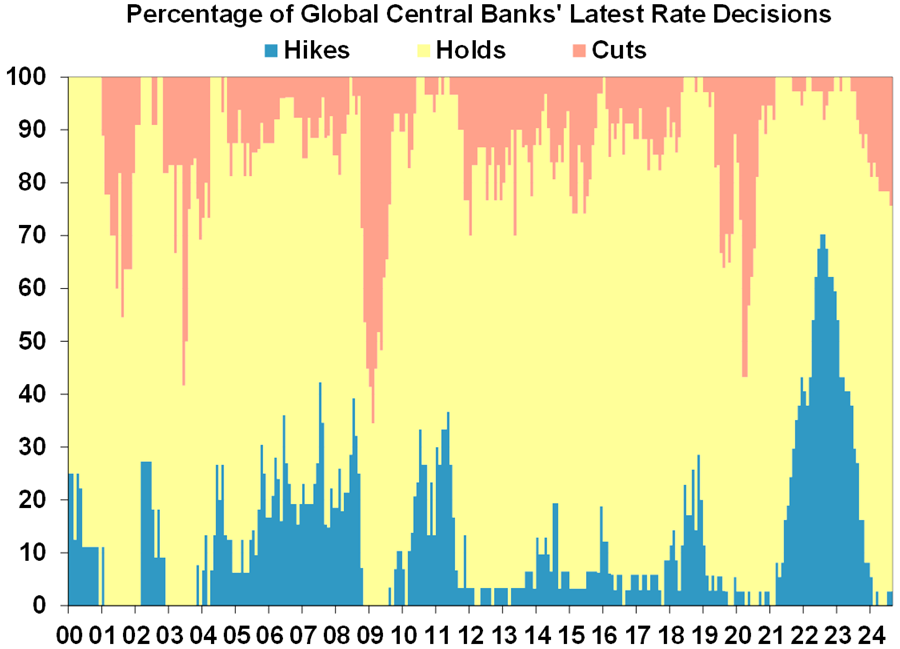
Source: Bloomberg, AMP
Fed on track for a September cut but it could be 0.5%. The Fed left rates on hold as expected at its July meeting waiting for more confidence that inflation is falling sustainably back to its target. However, its focus has shifted from mainly inflation to both inflation and employment and Powell indicated a rate cut could be on the table in September. July data showing a sharp slowing in US jobs growth, a further rise in unemployment to 4.3% triggering the so-called Sahm rule and indicating a now very high risk of recession and forward-looking jobs indicators pointing to softer jobs, higher unemployment and slower wages growth ahead all warn that the Fed is falling behind the curve. A 0.5% rate cut is now possible in September and the money market is pricing in nearly five 0.25% rate cuts by year end.
The Bank of England cut its policy rate by 0.25% taking it to 5% on the back of “progress in moderating the risks of persistence in inflation”. It was a close 5 to 4 vote, but Governor Bailey’s comments signal further cautious easing ahead, with the money market allowing for another two cuts this year.
Eurozone inflation was slightly higher than expected in July but, at 2.6%yoy and 2.9%yoy for core, is likely not enough to dissuade the ECB from cutting again in September. The money market is pricing in three and half more ECB cuts this year.
Australian inflation softer than feared. Three months of increases in a row in the ABS’ Monthly CPI Indicator had led many to fear a sharply higher June quarter inflation rate that would trigger more rate hikes. In the event, the Monthly CPI Indicator (yet again) gave a bad steer and June quarter inflation rose but only in line with RBA expectations and not enough to justify another rate hike. In fact, while much is made of Australian inflation being higher than in other countries this just appears to reflect the fact that it lagged other countries on the way up and so is just lagging on the way down, ie it’s nothing to get too alarmed about. And as we have been pointing out for the last few months – just as the US and other countries have seen setbacks in the process of getting inflation down, these countries have seen disinflation resume and the same is likely in Australia. This will be particularly evident this quarter as government cost of living measures could cut up to 0.7 percentage points off September quarter inflation potentially pushing it down to around 2.9%yoy. Of course, the focus will be on underlying inflation but even here falling cost and price pressures evident in the NAB business survey point to a down trend in trimmed mean inflation.
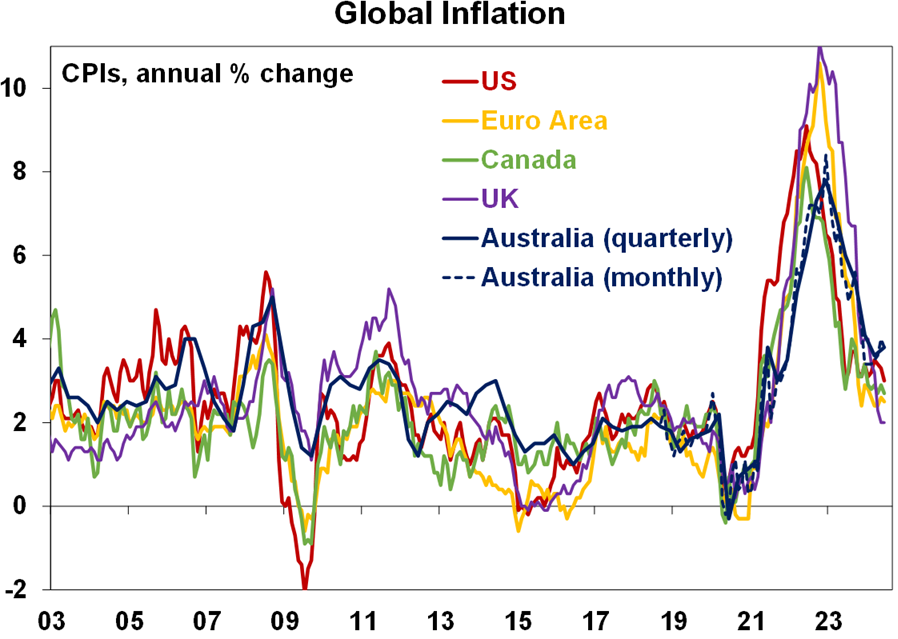
Source: ABS, AMP
RBA expected to leave rates on hold on Tuesday after lower than feared inflation, ahead of a start to rate cuts by February. Our assessment remains that the RBA’s cash rate has peaked and there is no case for another hike. In fact, given the US experience it should be moving to consider a cut. The June quarter inflation data was roughly in line with RBA expectations and unlikely to alter RBA expectations for inflation to return to the mid-point of its target in 2026. While inflation is still too high, the RBA will be mindful that: monetary policy remains restrictive; the full impact of past rate hikes is still feeding through; recession risks remain high as indicated by the ongoing slump in real household spending per capita and as population growth slows; forward looking jobs indicators warn of a significant further rise in unemployment ahead; wages growth has peaked which will slow services inflation; and inflation is likely to fall sharply this quarter as “cost of living” measures impact. What’s more, the US experience with hotter inflation earlier this year now giving way to cooler inflation again and a high and rising risk of recession suggests that the same thing could happen here. So, we expect the RBA to leave rates on hold at its meeting on Tuesday and reiterate that its “not ruling anything in or out”, albeit with a continued use of relatively cautious language as its still waiting “to be confident that inflation is moving sustainably towards the target range”.
In terms of the timing of RBA rate cuts a start in November after the release of likely very low September quarter inflation data is possible particularly if we see much weaker economic data and/or some sort of major financial shock - which given what’s happening in the US is looking possible! But in the absence of that it’s hard to see the RBA having enough confidence to begin cutting by then so we continue to see February after the release of December quarter inflation data as the most likely timing for the start of rate cuts. The money market no longer sees any further rate hikes in Australia and has fully priced a rate cut in December. As can be seen in the next chart, money market expectations have been swinging around a lot this year not helped by a bad steer from the Monthly CPI Indicator!

Source: Bloomberg, AMP
Bank of Japan getting more hawkish – how does that impact things? The BoJ announced that it will cut its bond buying in half by early 2026 and raised it policy rate from the range of 0-0.1% to 0.25%. This reflects increased confidence in the outlook for activity and inflation and points to further gradual hikes ahead, possibly taking the cash rate to 0.5% or slightly higher by year end. An obvious concern is whether this will drive a big reversal of the Yen carry trade (where money was borrowed cheaply in Yen and put into global assets), which would weigh on assets like US and Australian bonds and indirectly shares as the BoJ hikes and other central banks cut. I suspect the impact will be relatively minor though as Japanese rates will still be well below rates in other countries for some time to come.
The replacement of Biden with Harris has made the US election competitive again. Trump’s poll lead has narrowed, Harris is now seen more favourably and Harris and the Democrats are now seen as the probable winners of the election by betting markets (at around 54% Democrats versus 49% Republicans). The jokes have flipped from being about Biden to being about Trump and Vance like with their inane and offensive comments about Harris (“She was Indian…and then all of a sudden…she became a black person”) and “childless cat ladies”. Of course, there are still three months to go and at some point its likely markets will start to become more concerned again about Trump policies which point to new trade wars and potentially higher inflation.
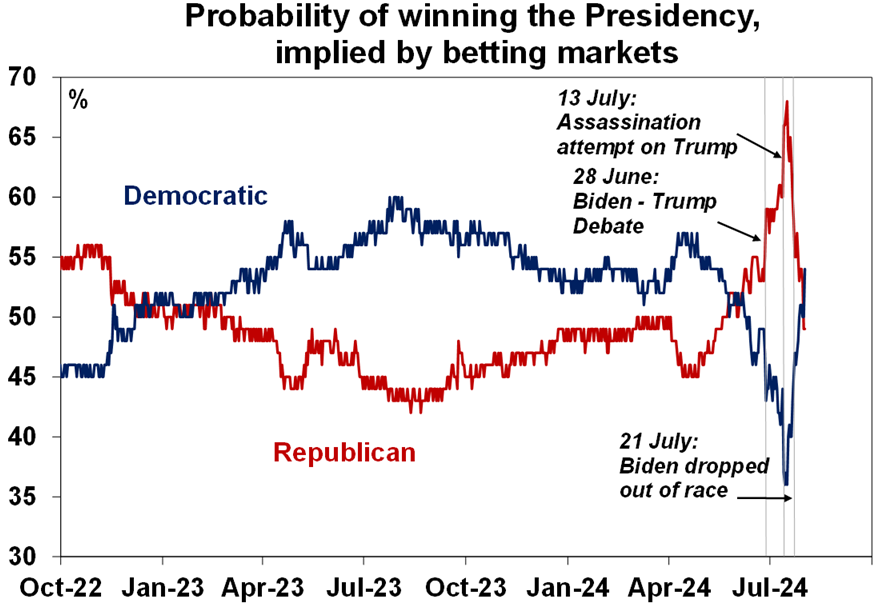
Source: PredictIt, AMP
Australia doing well at the Olympics so far. In terms of gold medals we are in the top five countries. Adjusting for population size we are surpassing those ahead of us in terms of medals per person.
Top 7 Olympic Medal Winning Countries so far
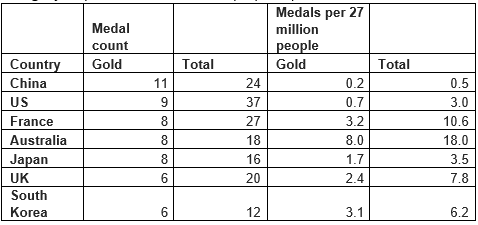
Source: AMP
Of course, the US and China may get an unfair advantage from their huge economies enabling them to spend more on athletes. See the chart below.
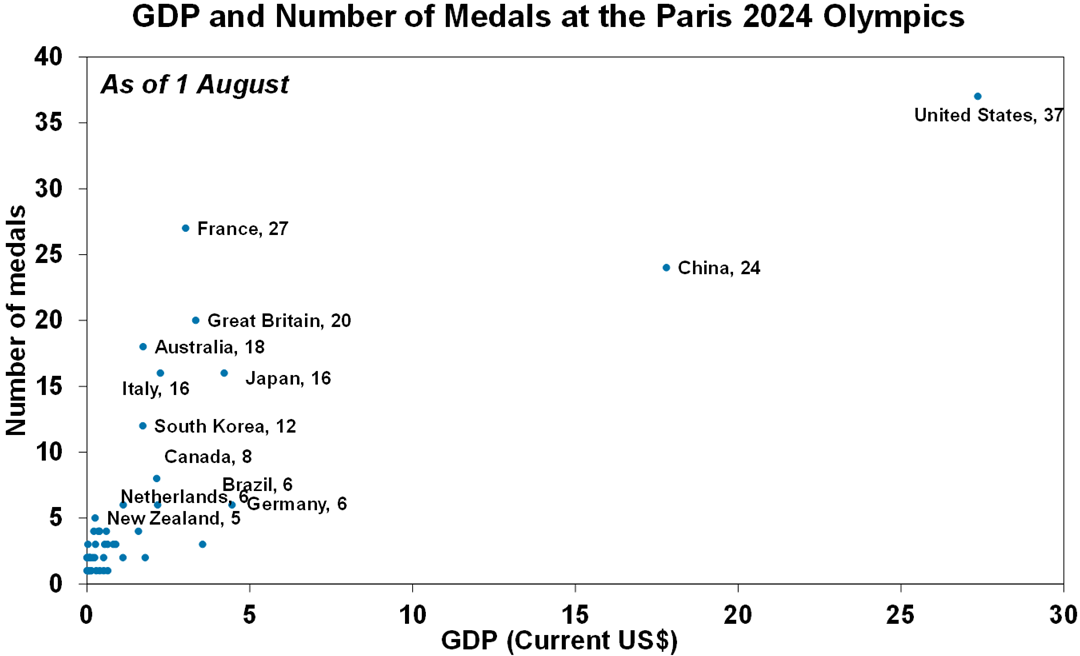
Source: AMP
Major global economic events and implications
US economic data was soft adding to growth and recession worries. The Conference Board’s measure of consumer confidence remains around average. The University of Michigan’s measure is below average. The ISM manufacturing conditions index fell further in July back to levels warning of high recession risk. May home price gains slowed again.

Source: Macrobond, AMP
US labour market slowing. Payrolls rose just 114,000 and unemployment rose to 4.3% both of which were worse than expected. Other jobs data was also weak with job openings, the quits rate (workers quitting for new jobs) and the hiring rate all down in June and the manufacturing ISM employment index for July fell to its lowest since 2020. All are pointing to lower jobs growth & higher unemployment ahead. Jobless claims also moved higher again.
Sahm recession rule triggered. The Sahm rule indicates a recession is commencing when the three-month average of the unemployment rate is up 0.5% from its low in the last 12 months. As of July, it’s up 0.53%. It has a perfect track record, but relationships that work in the past don’t always work in the future and it may have been distorted this time by a lumpy 420,000 rise in the labour supply in July. That said its hard to ignore and suggests along with the still inverted US yield curve and the slump in the US leading indicator that recession risk is very high in the US.
All this means even lower wages growth ahead, which means a further fall in inflation. Growth in the June quarter employment cost index slowed more than expected to 4.1%yoy, with growth in private sector wages and salaries slowing to 3.4%yoy. And growth in average hourly earnings in July slowed to 3.6%yoy. The falling quits rate points to a further slowing in wages growth ahead. What’s more strong productivity growth of 2.7%yoy means that unit labour costs are up just 0.5%yoy, well below levels consistent with the 2% inflation target.
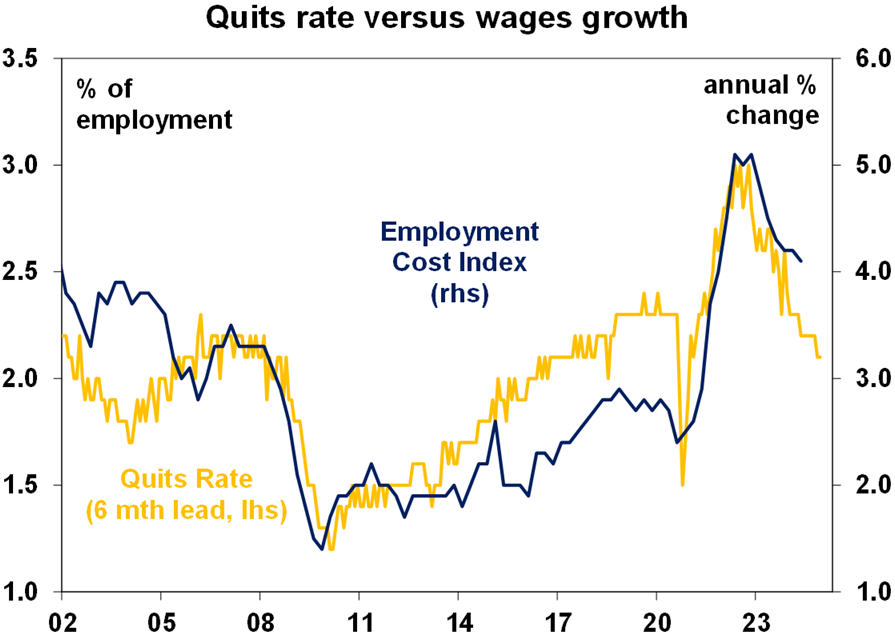
Source: Bloomberg, AMP
75% of US S&P 500 companies have now reported June quarter earnings. The results are good, but proving more mixed and weaker than hoped for from tech stocks. 79.2% have beat earnings expectations which is above the norm of 76% but below the experience of the last reporting season. Consensus expectations for earnings growth are now 9.7%yoy, up from 7.8% at the start of the reporting season.

Source: Bloomberg, AMP
Eurozone June quarter GDP growth was stronger than expected at 0.6%yoy, but much of the growth looks to have come from stronger net exports rather than domestic demand and looks concentrated in Spain. Meanwhile economic sentiment remained soft and unemployment rose slightly to 6.5%.
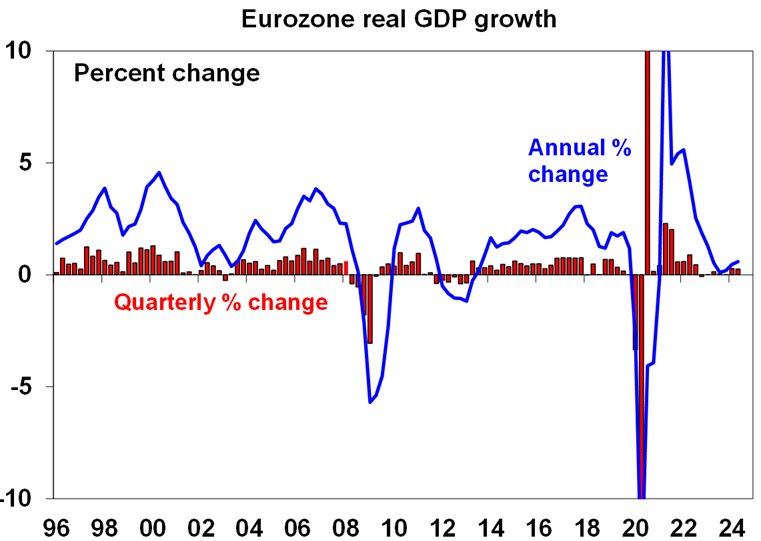
Source: Macrobond, AMP
Japanese economic data was mixed with industrial production and housing starts down but retail sales and consumer confidence up and unemployment down.
Unemployment up in New Zealand to 4.6% in the June quarter. This was in line with market and RBNZ expectations but reinforced expectations for a rate cut ahead. The money market has priced in a 72% probability of a rate cut this month.
Weak Chinese business conditions PMI’s but no new policy stimulus from the Politburo meeting. China’s official manufacturing and services conditions PMIs fell further in July and the Caixin manufacturing PMI which had been somewhat stronger till recently fell sharply catching down to the weak official PMI. While the Politburo repeated its pro growth commitments there were no additional stimulus announcements. Policy stimulus in China looks like remaining modest and incremental – maybe just enough to keep growth ticking along around the 5% growth target but with the risk that its not enough or too late. This is adding to commodity price weakness.
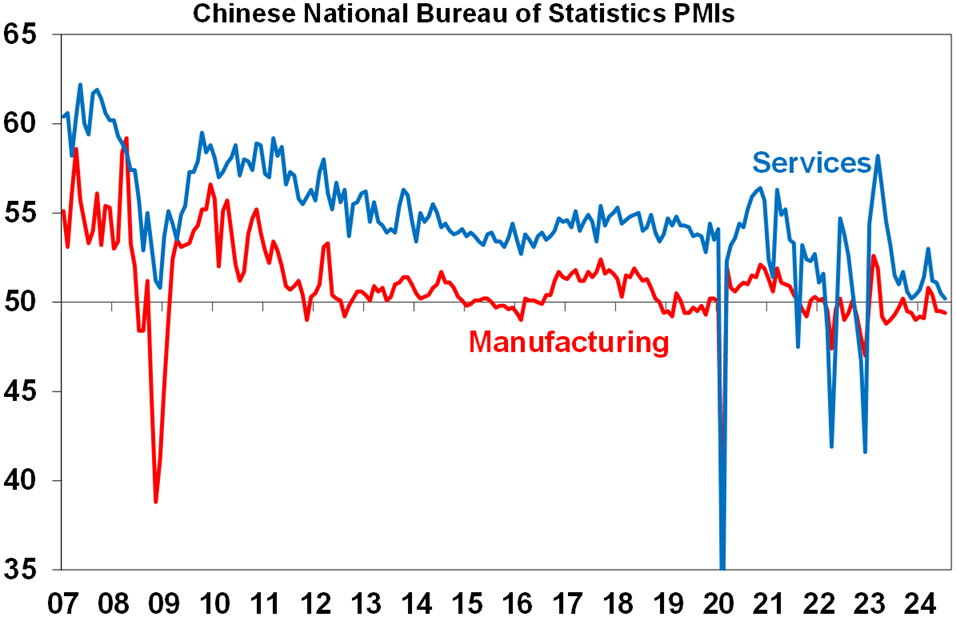
Source: Bloomberg, AMP
Australian economic events and implications
Australian economic data over last week was mostly soft. Retail sales rose solidly in June but as in May this was due to a stronger than normal boost from cash strapped consumers taking advantage of end of financial year sales, suggesting a pull back in July. Meanwhile, retail sales volumes fell another 0.3% in the June quarter and have now fallen in 7 of the last 8 quarter. Real retail spending per person is now well down from the post pandemic reopening highs and is barely above 2018 levels. The only things keeping nominal retail sales trending up over the last two years have been price rises and population growth.

Source: ABS, AMP
The weakness in consumer spending is also evident in the ABS’ Monthly Household Spending Indicator – albeit its been dramatically revised since the May release (which initially showed 0.1%yoy growth and now shows 4.9%yoy growth). Over the 12 months to June household spending is up 3.1%yoy which is ok but that’s in nominal terms and translates to a roughly 1% fall after inflation and a roughly 3% fall in real per capita terms.

Source: ABS, AMP
Home building approvals for June fell 6.5%mom, due to a sharp fall in volatile unit approvals. Approvals are running around an annual pace of 160,000 pa which is way below current underlying demand for around 250,000 dwellings a year.

Source: ABS, AMP
Home price growth slowing – with CoreLogic home price data showing more moderate growth of 0.5%mom in July. We expect price growth to slow further as poor affordability, high interest rates for longer and rising unemployment impact.

Source: CoreLogic, AMP
The ABS should ditch the Monthly CPI Indicator. From the get-go I have been sceptical about the value of a monthly CPI in Australia. It would just create more noise in investment markets, won’t result in better RBA decisions, will just use up ABS funding that could be better deployed elsewhere and the only beneficiaries will be traders and economists who think more data is always better than less and financial journalists who will have more to talk about. My scepticism has grown. From the chart below it looks roughly right – but as it does not include many key items in any one month it may not be of value until the final month in each quarter but that only comes out on the day of the quarterly release. And even then, its questionable. The October and November 2022 releases provided a poor guide to the December quarter 2022 CPI surge to nearly 7.8%yoy, the low readings in January and February this year exaggerated the fall in March quarter inflation and the rise in April and May this year led to exaggerated fears of a surge in June quarter inflation. (This likely exaggeration was one reason I thought the RBA would not be hiking again.) This led to excessive optimism about rate cuts early this year then endless talk of rate hikes more recently resulting in big swings in money market expectations from cuts to hikes and now back to cuts and endless noise in the media resulting in unnecessary angst for mortgage holders. The ABS should ditch it at least until it can get it right.
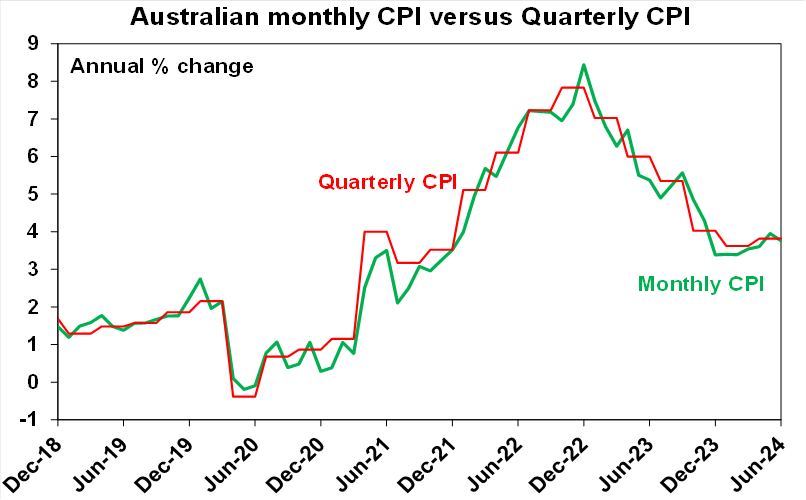
Source: ABS, AMP
What to watch over the next week?
In Australia, the focus will be on the RBA (Tuesday) which, as noted earlier, is expected to leave rates on hold, repeat that its “not ruling anything in or out”, but retain relatively cautious language and indicate that it’s still waiting “to be confident that inflation is moving sustainably towards the target range.” The RBA’s Statement on Monetary Policy is likely to revise up its 2024 forecast for unemployment to 4.4% (from 4.2%) and revise down its 2024 forecasts for GDP to 1.5%yoy (from 1.6%yoy) and revise down its headline inflation forecast for this year to 3%yoy (from 3.8%yoy) to allow for the impact of “cost of living” measures. As a result of slightly higher unemployment and slightly lower GDP growth along with the influencing effect of lower headline inflation its likely to leave its December 2025 forecasts for the CPI and trimmed mean inflation at 2.8%yoy and continue to forecast both back at the mid-point of the target range by June 2026.
A handful of Australian companies will also start to report June half earnings results including Mirvac, Transurban, AMP, Nick Scali and QBE in the week ahead. Consensus expectations are for a 3.5% fall in earnings for 2023-24 driven by a sharp fall in energy sector profits with miners, banks and consumer staples also expected to be down but with strong gains in profits for utilities, health care and industrials. Key to watch will be guidance around how the consumer is holding up with high interest rates and cost of living pressures along with indications around cost pressures and pricing power.
In the US, the services conditions ISM index (Monday) for July is expected to bounce back to 51 after a slump in June. The Fed’s June quarter bank lending survey (Monday) will likely show weak credit demand and possibly tighter bank lending standards. The June quarter earnings reporting season will continue.
Chinese trade data for July (Wednesday) is likely to show continued strength in exports but weak imports with CPI inflation (Friday) remaining weak at 0.4%yoy and producer prices remaining in deflation.
Outlook for investment markets
Easing inflation pressures, central banks moving to cut rates and prospects for stronger growth in 2025-26 should make for reasonable investment returns over 2024-25. However, with a high risk of recession, poor valuations and significant geopolitical risks particularly around the US election, the next 12 months are likely to be more constrained and rougher compared to 2023-24 and there is a high risk of a correction in the next few months.
We have raised our year end forecast for the ASX 200 to 8100. A recession is the main threat.
Bonds are likely to provide returns around running yield or a bit more, as inflation slows, and central banks cut rates.
Unlisted commercial property returns are likely to remain negative due to the lagged impact of high bond yields and working from home.
Australian home prices are likely to see more constrained gains over the next 12 months as the supply shortfall remains, but still high interest rates constrain demand and unemployment rises. The delay in rate cuts and talk of rate hikes risks renewed falls in property prices as its likely to cause buyers to hold back and distressed listings to rise.
Cash and bank deposits are expected to provide returns of over 4%, reflecting the back up in interest rates.
A rising trend in the $A is likely taking it to $US0.70 over the next 12 months, due to a fall in the overvalued $US and a narrowing in the interest rate differential between the Fed and the RBA. A recession is the main downside risk.

Weekly market update 22-11-2024
22 November 2024 | Blog Against a backdrop of geopolitical risk and noise, high valuations for shares and an eroding equity risk premium, there is positive momentum underpinning sharemarkets for now including the “goldilocks” economic backdrop, the global bank central cutting cycle, positive earnings growth and expectations of US fiscal spending. Read more
Oliver's insights - Trump challenges and constraints
19 November 2024 | Blog Why investors should expect a somewhat rougher ride, but it may not be as bad as feared with Donald Trump's US election victory. Read more
Econosights - strong employment against weak GDP growth
18 November 2024 | Blog The persistent strength in the Australian labour market has occurred against a backdrop of poor GDP growth, which is unusual. We go through this issue in this edition of Econosights. Read moreWhat you need to know
While every care has been taken in the preparation of this article, neither National Mutual Funds Management Ltd (ABN 32 006 787 720, AFSL 234652) (NMFM), AMP Limited ABN 49 079 354 519 nor any other member of the AMP Group (AMP) makes any representations or warranties as to the accuracy or completeness of any statement in it including, without limitation, any forecasts. Past performance is not a reliable indicator of future performance. This document has been prepared for the purpose of providing general information, without taking account of any particular investor’s objectives, financial situation or needs. An investor should, before making any investment decisions, consider the appropriateness of the information in this document, and seek professional advice, having regard to the investor’s objectives, financial situation and needs. This article is solely for the use of the party to whom it is provided and must not be provided to any other person or entity without the express written consent AMP. This article is not intended for distribution or use in any jurisdiction where it would be contrary to applicable laws, regulations or directives and does not constitute a recommendation, offer, solicitation or invitation to invest.
The information on this page was current on the date the page was published. For up-to-date information, we refer you to the relevant product disclosure statement, target market determination and product updates available at amp.com.au.

